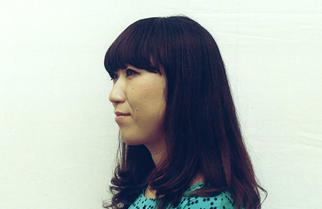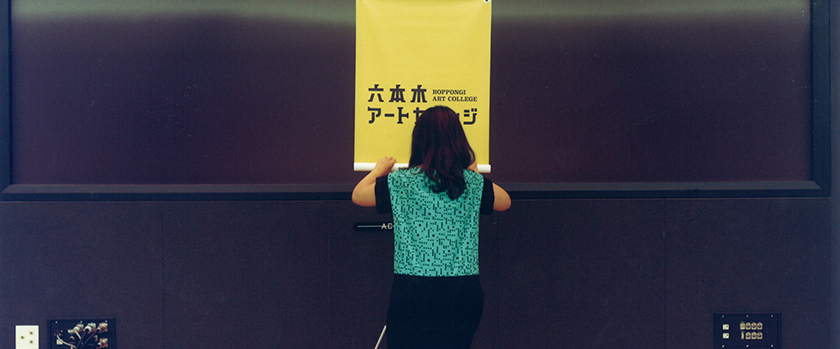
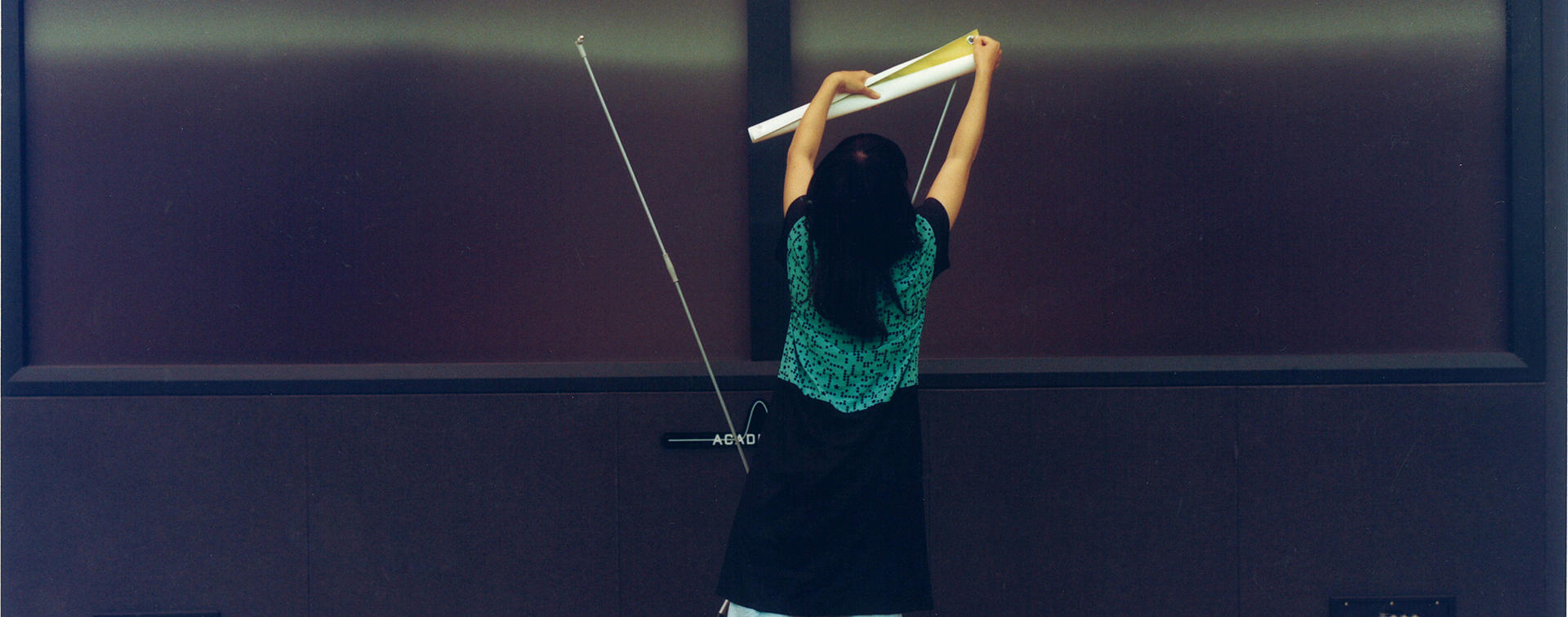
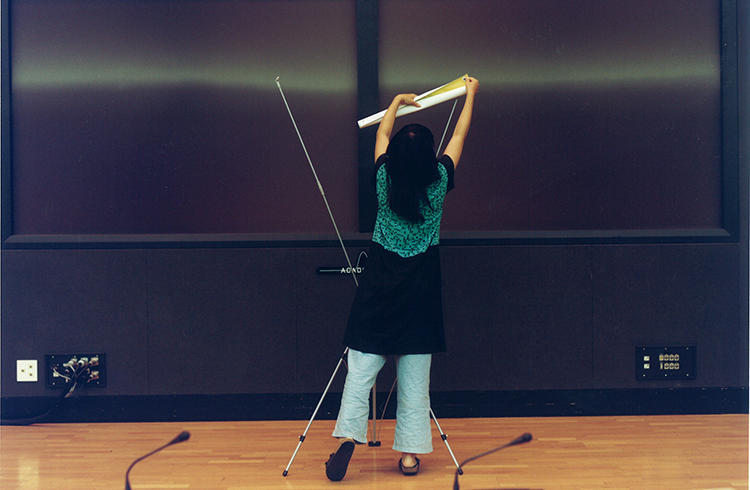
How would you turn Roppongi into an area of Design & Art?
Display participatory art which have a positive effect on people
- JP / EN
In her many roles such as movie director, author, stage director and radio personality, Ellie Omiya has attracted attention for her wide-ranging work. In February this year, she held her first exhibition, displaying written messages alongside installations. Omiya’s words have warmed the hearts of many people, sometimes even bringing tears to their eyes. This autumn, Omiya will be the instructor of the “Kotoba no chikara” (the power of words) workshop to be held at the Roppongi Art College. We asked Omiya about her views on art, and how she came to be involved with the genre. The interview shed light on the kind of art that Roppongi needs right now.
Art takes only a second to appreciate and yet has a long-term effect
I don't read that many books and I don't watch that many movies. I don't like the fact that books and movies are time-consuming; it can take a whole day to finish a book, and a movie requires at least two hours. What has had an influence on me is art. Art is something that can be appreciated instantly. It's over in a second and yet it lingers on your mind for a long time. You ponder about the meaning of the work and ask questions to yourself. A work of art does not impose a story on you; it allows you to make your own interpretation. Art lets you become very philosophical or very poetic - it allows you to expand your world.
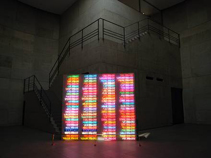
Bruce Nauman "One Hundred Live and Die"
I often go to art museums. When I went to the Benesse House Museum in Naoshima, Kagawa Prefecture, the work that left the biggest impression on me was "One Hundred Live and Die" by Bruce Nauman. There are these numerous words in neon tube lights that flicker on and off. Looking at it, my gloomy mood was suddenly dispelled. I thought, "Here in this moment on earth, there are people who crying and people who are laughing. It's all happening at the same time." I felt as if I were looking down on the world from the far end the universe, and it cheered me up.
There have been many similar occasions where works of art have filled me with energy, and that's why, when I held my exhibition in Shibuya (at the Parco Museum) in February, I wanted to do something to let people see the appealing aspects of art that I have always sensed. My aim in setting up the eight installations was to show things which people can understand at a glance and yet which would linger on their minds, prompting them to take the next step. The interactive installations and writings are intended to let people re-experience and reconfirm feelings that arise from the act of conveying thoughts - feelings such as loneliness, wistfulness, or being moved.
Beach of undelivered thoughts
I hope you don't mind me talking about my own works. There is an installation I made called "Message Bottle" that has blue message bottles strewn over white sand; it represents a scene of bottles washed up on a beach called "the beach of undelivered thoughts." The visitors can write the feelings they were never able to express and put them in the bottles. I wrote a few messages myself and slipped them in the bottles. One message I wrote was, "I thought we would always be together."
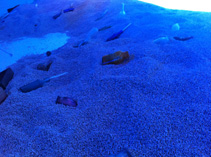
message bottle
Visitors can pick up and open the bottles and read what other people have written. I've read some really remarkable messages. It's strange, but there's this "law of attraction" and you tend to pick messages that are most suited to you in that moment. There are messages where people have made confessions or said they wanted to apologize.
This beach is like a graveyard for messages. What I wanted to say through this installation is that unless you convey your thoughts to someone, your feelings might as well not exist. The messages everyone writes are simple; some make you catch your breath and some make you appreciate the thoughts of people. I would be glad if this installation could remind people of the thoughts they need to tell someone and encourage them to go and actually meet them. I think this "Message Bottle" installation would be interesting to exhibit outdoors in a place like Roppongi.
Participatory artwork is suited to cities and ideal for communication
All you do is write a message and put it in a bottle, so anyone can participate in this. This kind of artwork allows passersby to easily take part, and makes art more accessible to people. There are lots of grand art museums for exhibitions of "so and so", but apart from these events, there are no places that have permanent participatory artworks standing unobtrusively in the streets.
I think that participatory art is particularly suited to cities where there are many people. A person who came to see the "Message Bottle" installation said, "This was an unexpected way to connect with people." That comment left an impression on me. I realized that it's not easy to make face-to-face communication, but it's easier if it's in an indirect manner. You don't tense up reading a message left behind by a person you don't know.
Also, the pretty sight of the blue glass bottles makes it easy for people to take part. It would probably be difficult to do this "convey your thoughts" project in a witty way. Roppongi is a stylish place and has a fairly dry atmosphere, so I feel that participatory art would be compatible and be a good tool for communication.

A "Lonely Telephone Box" in Roppongi
There is another piece of artwork I would love to have placed in Roppongi. It's one of the eight installations from my exhibition and it's titled "Lonely Telephone Box." You go inside the box when you are feeling lonely. I made it for people who are thinking, "I'm lonely so I want to see someone, but actually I don't want to see anyone. Oh, but I'm lonely..." At the exhibition (in February), people were waiting for about two hours to go inside this telephone box. The installation became a place for crying out loud. I thought, "I see. Everyone is feeling so lonely." Both men and women were really crying as they came out of the box.
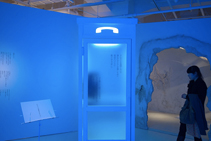
Lonely Telephone Box
When you go inside and pick up the phone, you can hear "moshi moshi (hello)" in a variety of voices. It's so reassuring to hear that "moshi moshi." There are times when you venture to call someone even when you have nothing particular to say, and when you hear "moshi moshi", you feel heartened. There is a recorded message that goes, "moshi moshi", followed by "How are you?", "Everything's alright." and "See you tomorrow." There were really so many requests for the telephone box to be available in the streets. People said they would like to use it when "their hearts are tired."
Metropolitan places like Roppongi can be so sophisticated that there seems to be no room to relax, and it can become suffocating. I think it would be nice to have art in such places to soften people's feelings.
Art which positively affect people's hearts
The important thing is not to just exhibit artworks, but to have people participate in them. You learn something by taking part. People told me that with the "Lonely Telephone Box", they realized how warm the human voice sounds, and that they became aware for the first time that "moshi moshi" is reassuring. Those comments made me really glad. With an imposing piece of artwork by a famous artist sitting in an exhibition, people will say, "That's marvelous," and that's it. But I think artworks are meaningful when they give people hints and help them notice things, and affect their hearts.
When pondering art, what matters to me is the human heart. It may not be a refined theme, but thoughts and feelings are what I care about. It's a theme that I think people understand. I want to make works that soften people's feelings or let people laugh at themselves for having inferiority complexes or let them look at their tough workplaces as interesting places; my expressive activities are driven by the desire to make things that will affect the heart. The reason for this is that I myself find it difficult to live without such things.
Why I became involved with art
When I get up in the morning, there are times when I feel mentally ruffled. I think that there must be quite a lot of people living in the city who are like me in that way. Sometimes I feel rumpled inside because of the lingering memories of the day before. So I used to "tune" my heart by listening to music. I would play calming music, or if I was in a dull mood, I would play lively music.
But one day, I felt doubtful about this and consulted a friend of mine who does counseling work. My friend said, "You should take a good look at your inner feelings." My first reaction was to think, "But I do quite a lot of that already." Then it dawned on me that I'd been afraid to look deeply inside myself. I was frightened of learning why I felt rumpled inside. So I decided to delve deeper and learned that I felt hurt because of a comment someone had made. Knowing why made me feel refreshed. After all, it's a very human thing to have hurt feelings. I thought to myself, "It's alright if the sky is cloudy sometimes." and I felt very alive. It's not easy to express all of this with words, and that's why I decided to express it through art.
I was able to feel better by making realizations and getting hints, and I wanted to help make other people feel better too by sharing those hints and realizations. Life is about the life stories of every person, and it seems to me now that art is the best way to convey my thoughts and let people know about the things I care about.
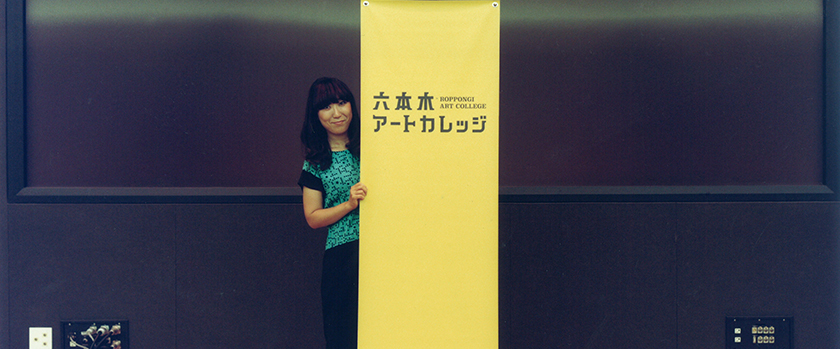
A housewife's sunny-side up eggs can be art
I'm not an expert on art. I like art but I am not knowledgeable about it. But I think everyone can be and should be an artist. For example, a pedestrian walkway might need to be painted blue and a painter might get the idea of painting in clouds as well to cheer up the drab street. He might think of pleasing the pedestrians with the pretty sky-like design. The moment he gets the idea, he becomes an artist. A housewife might make the same sunny-side up eggs every day, but one day she might try to offer something different for her family and draw a face. In that moment, those sunny-side up eggs become a piece of art.
You can physically live without art, but when you have art, life becomes more fun. So in that sense, I think that art - like music - is indispensable.
Art that lives in the streets
The current works of art and design in Roppongi seem to be kind of special, and have an aura of luxuriousness. I think if you want more people to participate in art and design, and make people-participation the defining characteristic of Roppongi, art and design need to become established as a culture.
When you go abroad, there are places where you can hear music coming from the churches, or see people performing on the street. You can tell that many of the people there are musicians and that they really love music. It's as if the music lives in the streets. It would be difficult to turn Roppongi into an area of design and art unless people get the tangible feeling that design and art are actually living in the streets.
It would be good if more artists and designers could come and live in Roppongi. Ideally, it should be a place where not the heavyweights, but the up-and-coming artists choose to live. The high rents are probably the biggest drawback to living in Roppongi, so my proposal would be to set aside an area for young, budding artists.
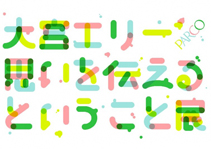
"Conveying Thoughts" Exhibition
An exhibition that was held Feb. 3-27 in Shibuya's Parco Museum. Eight installations were displayed representing the feelings such as "loneliness", "exhilaration", "wistfulness" and "being moved" that are evoked from the act of conveying thoughts. Many visitors said they were touched by the exhibition.
Artistic activities of an educational nature
More than 10,000 visitors came to the exhibition of my works at the Parco Museum. The exhibition is currently still touring Sapporo and Kyoto. I didn't think that it would make so many people happy. I was really surprised when people told me they were glad they came or when I saw them cry. I am also grateful that so many people gave me kind words through Twitter. I would like to continue doing exhibitions and be directly involved with people. I wish to put my energies into activities that will connect people's consciousness.
In the future, I would like to do work of an educational nature. It may be presumptuous of me to talk about education, but I hope to be involved with community activities where everyone contributes their thoughts. The activities in themselves would be art, and it would be nice if that form of expression could affect people's hearts.
information
ROPPONGI ART COLLEGE 2012
Oct. 8 (Mon) 2012 10:00~18:30
A one-day event in Roppongi Hills where a total of 23 workshops will be held by artists and creators on the concept of "Energy charge with art". The workshops, which participants can choose freely from, will be held at "Roppongi Academy Hills 49" in the Mori Building.




